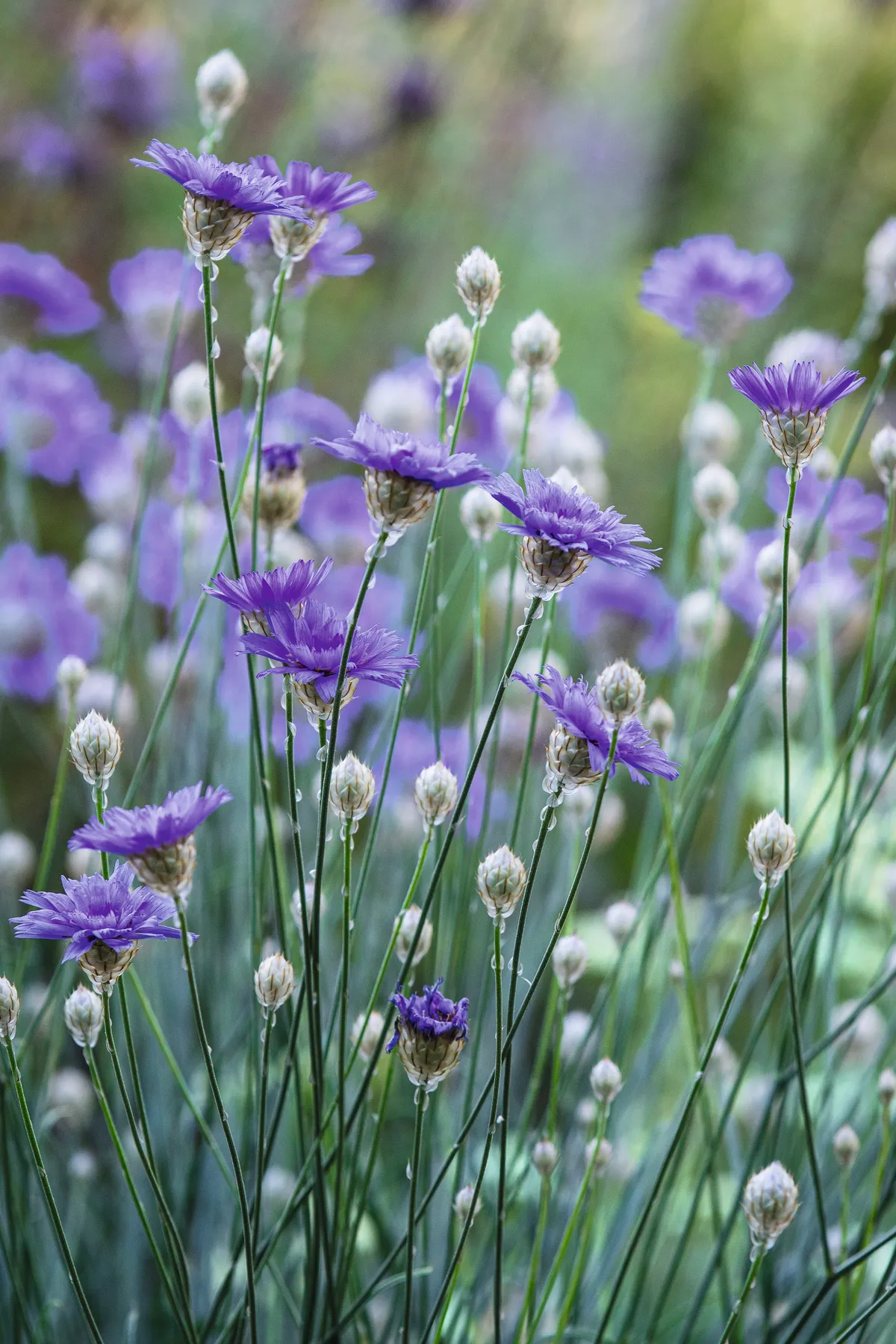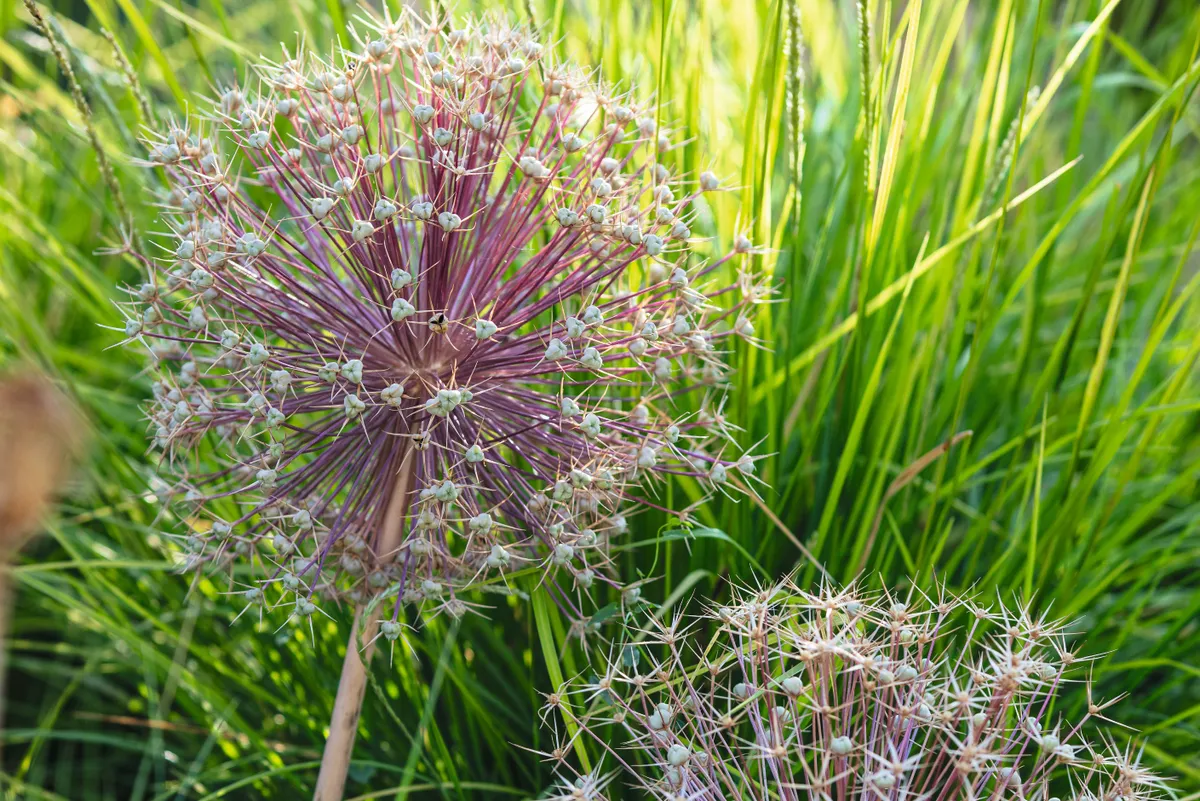It’s not often that your first sight of a garden is from above. But Le Jardin Champêtre in the Occitanie region of southwest France offers just that opportunity. Set in a river valley, the garden sits four metres below the road allowing you the opportunity to take in the garden’s informally arranged shrubs, grasses and perennials, before climbing down to explore its gravel pathways more fully. This view from the road was one of the reasons, its owners Imogen Checketts, a former head gardener at Pensthorpe Natural Park in Norfolk, and horticulturist Kate Dumbleton bought the land to base both their garden design practice and a small nursery.

“We love the landscape here,” says Kate. “We are in a small, fertile river valley but we have limestone behind us. In minutes you can be high up looking at the Pyrenees, and there are miles and miles of wild landscape with wildflowers such as euphorbias, lavender and phlomis.”
While their garden offers opportunities for Imogen and Kate to trial techniques and plants, it is also a garden designed to be enjoyed – and to act as a stylish showcase for the nursery and design practice. “We have open weekends, which we find more effective than regular opening,” says Kate. Their client base comes entirely by word of mouth, which has its benefits, but as Kate points out can bring its own problems. “There is the challenge of doing different plantings in places where so many people know each other – we don’t want to repeat ourselves,” she says.
Still a young garden, Le Jardin Champêtre will be exciting to watch in future years. Part of a new generation of Mediterranean-zone gardens that are dramatically increasing planting possibilities, its flora and experience may well help gardens elsewhere make the necessary adaptations to climate change. Read on for details of the planting and design at Jardin Champêtre.

The rich garrigue flora of the surrounding limestone hills helps to inspire Imogen and Kate’s planting. Lavenders provide early summer interest, alongside the yellow Petrosedum rupestre, which functions as a drought-tolerant groundcover, alongside Russian sage, Salvia yangii, a reminder that central Asian steppe species often flourish in Mediterranean gardens
Grasses, including the short-lived but readily self-seeding Stipa tenuissima, thrive in the garden’s alluvial soil, but are an unusual sight in Mediterranean gardens. More common is Achillea coarctata, an effective groundcover species that Imogen and Kate use as a lawn alternative. They’re starting to phase out high-maintenance lavenders, such as Lavandula x intermedia ‘Impress Purple’ and ‘Alba’ and slowly replacing with Eriogonum fasciculatum.

Looking out over the garden from the entrance you’re met with a sea of lush green, created mainly with different cultivars of Miscanthus. Later in the summer these will flower and the seedheads will last well into the winter.

Pistacia lentiscus, pruned to show its multistemmed trunk, will be a long-term component of this part of the garden. The mat-forming Frankenia laevis is an effective low groundcover, surrounded by delicate flowers, including Verbena bonariensis and Catananche caerulea, and grasses such as blue-grey Helictotrichon sempervirens. Although there is no gravel garden here, Imogen and Kate make extensive use of gravel mulching, which helps to reduce weed seed germination as well as keeping the soil cool and moist.

Planting is in layers, covering all the soil with a base dominated by grasses, including the silvery heads of Pennisetum orientale and tufted bluegreen leaves of Schizachyrium scoparium. At the back Amelanchier canadensis and tall grass Stipa gigantea are underplanted with bulbs, including Allium sphaerocephalon and Allium cristophii, its seedheads left to prolong interest, and perennial.

The foliage of Miscanthus sinensis ‘Saturnia’ creates a lush lead for this border alongside Bupleurum fruticosum, which dominates here. It’s a long-lived shrub that rapidly establishes itself and is ideal for dry summer climates. Here this remarkably useful shrub works well with Euphorbia characias subsp. wulfenii, the blue Salvia yangii, which flowers later than many dry-habitat species, and self-seeding purple Verbena bonariensis.

Grasses again add structure to this border, with Miscanthus sinensis ‘Yaku-jima’ and Stipa gigantea giving both shade and protection from wind to the planting below. Here the muted whites of Eriogonum fasciculatum and Achillea millefolium, and grey spires and foliage of Stachys byzantina, contrast with the bold flowers of Lavandula x intermedia ‘Impress Purple’ adding a burst of colour.
16 key plants from Le Jardin Champêtre
Catananche caerulea

Greyish foliage with flowers on 1m-high stems. Plants are narrow so best grown in groups or intermingled with other plants. Short-lived perennial. 1m x 30cm. RHS H5, USDA 4a-7b†.
Echinops ritro

Thistle-like foliage in a non-spreading clump. Flowers followed by short-lived but attractive seedheads. 90cm x 45cm. RHS H7, USDA 3a-8b.
Eragrostis elliottii

A beautiful, clump-forming grass from the southeastern USA that excels in hot, dry conditions. Its fine, fawn-coloured foliage ages to tan, and in late summer its arching stems are topped with delicate smoky-grey flowers followed by attractive seedheads. 80cm x 60cm. USDA 6a-9b.
Eriogonum fasciculatum

A long-lived shrub native to the American West Coast, with papery, grey-white flowers and attractive small leaves. Can be hard-pruned and is very drought tolerant. 1.8m x 2.4m. USDA 7a-11.
Frankenia laevis

A mat-forming perennial that is the shortest of the groundcovers Imogen and Kate grow. Its foliage turns a lovely red in autumn. Probably not as drought-tolerant as thymes. 1-4cm.
Glaucium flavum

The yellow-horned poppy is a short-lived perennial, often grown as a biennial, with striking orange flowers and seedpods. A coastal plant, it has a habit to self-seed in stony places. 50cm x 30cm. RHS H4, USDA 5b-10b.
Origanum syriacum

A semi-shrubby oregano relative, with a rather leggy habit, but it can be pruned into shape. It’s one of the key ingredients of za’atar, used in Middle Eastern cooking. 60cm x 45cm. RHS H4, USDA 9a-10b.
Pennisetum orientale

‘Tall Tails’ One of the best of the genus, forming slowly expanding clumps of neat foliage and creamy, pink-tinged flowerheads. Not notably drought-tolerant. 1.5m x 90cm. RHS H3, USDA 5a-8b.
Achillea crithmifolia

A drought-tolerant groundcover with grey foliage that Imogen and Kate keep mown short like a lawn. It’s strongly spreading, so best kept to areas where it can be contained or spread isn’t a problem. 20cm.
Achillea coarctata

Another groundcover that Imogen and Kate also mow like a lawn, but slower growing than A. crithmifolia and with a more patchy appearance. Elegant silvery leaves and attractive yellow flowers. 15cm.
Achillea millefolium

The common and best-known yarrow, it is also a notably drought-tolerant potential groundcover, but with lusher foliage. Flowers are usually white. 90cm x 60cm. RHS H7, USDA 3a-9b.
Allium cristophii

Spectacular large heads of metallic purple flowers are followed by seedheads that last until early autumn. Good for drier soils. 60cm x 20cm. RHS H5, USDA 4a-8b.
Allium sphaerocephalon

Dark purple flower heads on what is a narrow and insubstantial plant, so best grown in quantity and scattered among other plants. 90cm x 8cm. AGM*. RHS H6, USDA 4a-8b.
Asphodeline lutea

Striking, early summer, clump-forming perennial with upright stems. Good for dry or stony soils. 90cm x 30cm. RHS H4, USDA 6a-9b.
Bulbine frutescens

Amazingly drought-tolerant, slowly spreading perennial, like a miniature Kniphofia. Makes a good groundcover. 45cm x 45cm. RHS H3, USDA 9a-11.
Bupleurum fruticosum

A rapidly growing, long-lived evergreen shrub with glossy, blue-green foliage and yellow flowers in summer. An excellent coastal plant. Easily clipped into various shapes. 2m x 2.5m. RHS H4.